5 Key Differences Between Home Staging and Interior Design

When it comes to preparing a home for sale, home staging plays a crucial role in creating a welcoming environment that appeals to potential buyers. While it may seem similar to interior design, there are distinct differences between the two. Here are five ways in which home staging sets itself apart from interior design:
1. Purpose and Goal
Home Staging: The primary goal of home staging is to make the home appealing to the highest number of potential buyers, thereby selling the property more swiftly and for more money. It’s about creating a neutral canvas that buyers can envision themselves living in.
Interior Design: Interior design is tailored to the homeowner’s personal taste, lifestyle, and comfort. It’s about creating a space that reflects the personality and preferences of the inhabitants.
2. Target Audience
Home Staging: Home staging is designed to attract a broad audience. Stagers aim to depersonalize the space, making it easier for buyers to imagine themselves in the home.
Interior Design: Interior design is specific to the client’s desires. Designers work closely with homeowners to create a space that suits their unique style and needs.
3. Duration and Longevity
Home Staging: Staging is a temporary setup intended to last only until the home is sold. The design choices are made with the sale in mind, not for long-term living.
Interior Design: Interior design is meant to last for years. It involves selecting quality pieces and finishes that will endure the daily life of the homeowners.
4. Budget and Investment
Home Staging: Budgets for home staging are typically smaller because the changes are not permanent. Stagers often use rental furniture and accessories to keep costs down.
Interior Design: Interior design can be a significant investment. Homeowners are willing to spend more on furniture, renovations, and custom pieces that they will enjoy for a long time.
5. Flexibility and Creativity
Home Staging: Stagers need to be flexible and resourceful, often working with what is already available in the home and enhancing it to appeal to buyers.
Interior Design: Designers have the creative freedom to start from scratch or overhaul a space entirely based on the client’s wishes and budget.
In conclusion, while both home staging and interior design focus on aesthetics and functionality, their approaches, objectives, and methods are uniquely tailored to their specific purposes. Understanding these differences can help sellers and designers alike to achieve their respective goals effectively.